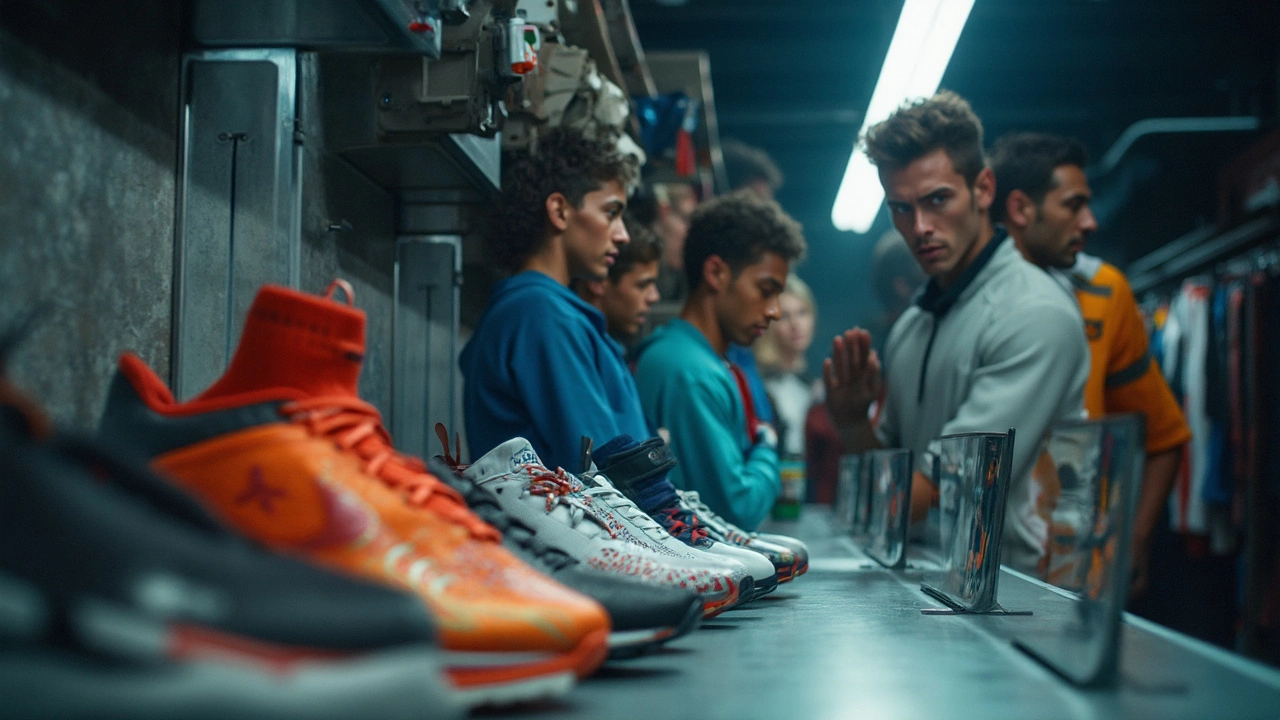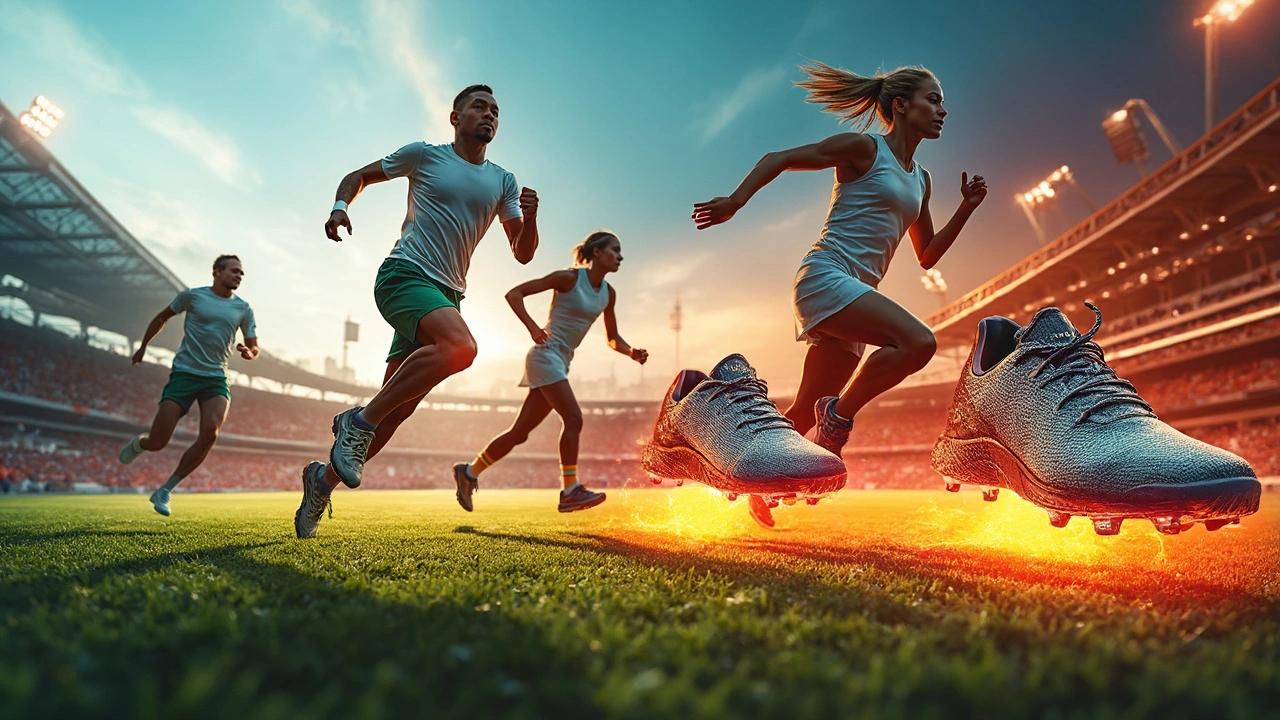Is Shoe a Sport Equipment? Breaking Down the Facts
 May, 6 2025
May, 6 2025
Think about stepping onto a basketball court or soccer field barefoot. Sounds painful, right? That's because the right shoes do way more than just cover your feet—they unlock your performance, protect you from injuries, and can even boost your confidence.
If you've ever wondered whether shoes are really in the same league as rackets, helmets, or gloves, you're not alone. Plenty of folks think of shoes as just clothing, but in sports, they're a whole different beast. They’re designed with traction patterns, shock-absorbing soles, and materials that help you move fast without hurting yourself.
Athletes don’t lace up just any pair of sneakers. Brands engineer specific shoes for running, tennis, soccer, and nearly every sport out there. The shoe you pick can actually make the difference between a twisted ankle and a winning sprint. Really, if you take away an athlete's shoes, you’re taking away a vital piece of their gear.
- What Makes Something Sports Equipment?
- How Sports Shoes Became Essential
- The Tech Inside Athletic Shoes
- Choosing the Right Shoe for Your Sport
- Do Shoes Qualify as Must-Have Equipment?
What Makes Something Sports Equipment?
So, what actually turns an ordinary item into official sports equipment? It’s not about style or just having a cool design. The real deal is about function—if a piece of gear is made to help you play, practice, or stay safe in a specific sport, it counts as equipment. That’s why no one calls jeans sports equipment, but shin guards and helmets make the cut every time.
Let’s break it down further. According to most sports organizations, something qualifies as sports equipment when it:
- Directly helps you perform better or more safely during a sport
- Is designed or regulated for use in that particular sport
- Protects you from injury (think mouthguards or batting helmets)
- Can be required or recommended by official rules
If you’re still wondering whether shoes belong in this group, think about how rules for soccer, basketball, or running always mention specific footwear. For many sports, you can’t even join an official game without the right shoes—it’s about safety and performance, not just looks.
Check out how equipment gets divided up in many sports:
| Type | Example | Purpose |
|---|---|---|
| Apparel | Jerseys, socks | Identity, comfort |
| Equipment | Shoes, bats, rackets | Performance, safety |
| Protective Gear | Helmets, pads | Prevent injuries |
The bottom line is, if an item is necessary for playing or improving in a sport, it’s probably considered sports equipment. Shoes tick all those boxes, which is why you’ll always find them on the list—and why shopping for them isn’t just about what looks good with your shorts.
How Sports Shoes Became Essential
Back in the day, athletes pretty much played in whatever shoes they had lying around. There were no special kicks for running fast or making sharp turns on a soccer field. Over time, though, folks started noticing that injuries were common and performance could be way better with the right pair of sports equipment on their feet.
Let’s hit a few highlights from shoe history. The first spikes for running appeared in the mid-1800s, and by the 1920s, brands like Converse were making specialized basketball sneakers. Fast forward to the 1970s, and the running boom had companies pouring money into developing lighter, stronger, more cushioned shoes. That’s when you started seeing real splits between gear for each sport: thick-soled shoes for running, cleats for soccer and football, grippy soles for tennis.
Professional athletes started setting world records and breaking barriers—not just because they trained hard, but also because their athletic gear kept improving. For instance, when running shoes dropped in weight and added serious shock absorption, marathon times around the world improved. The story’s the same in other sports: better traction means fewer slips, and more support means fewer rolled ankles.
Brands didn’t just guess what to make. They studied how athletes used their feet, measuring the pressure, angles, and patterns as people moved. Take a look at how sports shoes have evolved over the last century:
| Era | Key Development | Impact on Sports |
|---|---|---|
| 1920s | Canvas basketball shoes (Converse) | More control on court |
| 1950s | First molded soccer cleats | Improved traction on grass |
| 1970s | Lighter running shoes, added cushioning | Longer races, fewer injuries |
| 2000s | Custom-fit shoes, sport-specific tech | Boosted athlete performance |
Bottom line: shoes aren’t just an add-on to your sports outfit. They’re a piece of equipment that’s evolved as much as tennis rackets or football helmets. That’s why picking the right footwear for your sport isn’t just smart—it’s essential.

The Tech Inside Athletic Shoes
If you think all sports shoes are built the same, you’re missing out on some cool details. Modern athletic shoes pack serious science to keep you quick, light, and safe. Let’s break down what’s actually under your feet.
The sole is where everything starts. Take running shoes: they’ve got rubber outsoles for grip, squishy foam midsoles for cushion, and flexible uppers for comfort. Brands like Nike and Adidas spend millions inventing foam that gives you bounce without weighing you down. For example, Nike’s ZoomX foam is famous for helping marathon runners shave off minutes from their best times.
Beneath the surface, you’ll also find surprise ingredients like carbon plates in high-speed shoes. These plates bend and snap back with every step, pushing you forward. Runners in carbon-plated shoes have set records—at the 2019 marathon in Vienna, Eliud Kipchoge wore shoes with a carbon plate while breaking the two-hour mark.
Basketball and tennis shoes are a bit different. They use flat, patterned outsoles for traction, so you stop and turn without sliding. Some even pack in air, gel, or customized padding to soak up shock when landing from jumps. It’s not just about comfort—the right shock absorption can help prevent knee and ankle injuries.
| Sport | Key Shoe Feature | Main Benefit |
|---|---|---|
| Running | Lightweight foam, carbon plate | Cushioning, speed boost |
| Basketball | Strong ankle support, thick padding | Stability, impact protection |
| Soccer | Studded outsole | Better grip on grass |
Some shoes even use smart tech—like connected insoles that track your steps, jumps, or balance. Still, the classic stuff—traction, cushion, fit—matter most. If a shoe doesn’t match your sport, you can mess up your performance or end up injured.
So next time you shop for sports equipment, take a minute to see what’s really inside those shoes. Good athletic shoes are engineered for your foot, your sport, and your goals. Pick right, and your body will thank you.
Choosing the Right Shoe for Your Sport
Picking the right sports shoes isn’t just about matching your outfit. The kind of shoe you need totally depends on your sport. A huge mistake people make is wearing their running shoes to play basketball or using tennis shoes for soccer. This can mess up your performance and even put you at risk for injury.
Let’s break down what matters when you’re looking for the right pair for your sport:
- Running: You want lightweight shoes with lots of cushion for shock absorption. Road running shoes focus on smooth treads, while trail running shoes have grippier soles for mud and rocks.
- Basketball: Go for high-tops if you want extra ankle support. The soles need strong grip because court sports are all about quick stops and starts.
- Soccer: Cleats are non-negotiable. Turf, grass, and indoor shoes are totally different because the surface changes how you move and what kind of traction you need.
- Tennis: Tennis deals out tons of lateral movement. Tennis shoes offer durable sides and stable grip designed for sudden side-to-side action.
- Weightlifting: Flat soles are the go-to. This gives you a solid base for lifting, especially compared to the squishy soles on most running shoes.
Ever heard that almost 70% of sports injuries below the knee are linked to the wrong footwear? That's what a 2023 survey from a major sports medicine group suggested. Wearing the right footwear makes a real difference.
| Sport | Key Feature |
|---|---|
| Running | Cushion & Shock Absorption |
| Basketball | Ankle Support & Grip |
| Soccer | Surface-Specific Cleats |
| Tennis | Side Reinforcement |
| Weightlifting | Flat, Firm Sole |
If you’re shopping, always try shoes late in the day (feet swell), wear your usual sports socks, and walk around the store. Don’t ignore little pinches or loose spots—they get worse after a while. And if your sport is your main hobby, it’s smart to replace your athletic gear shoes every 300-500 miles or roughly once a season, depending on the damage.

Do Shoes Qualify as Must-Have Equipment?
When you look at what counts as sports equipment, the main idea is simple: does it help keep you safe, boost your performance, or let you play by the rules? Shoes easily check all those boxes, and it’s not just about preference—it’s about what’s required.
Major sporting bodies like FIFA and the NBA straight-up demand specific types of footwear for matches. Ever try running a marathon barefoot? Technically you could, but race organizers usually don’t love the idea. Even in youth leagues, wearing the right athletic gear isn’t just a suggestion—it’s a rule.
Here’s why shoes take their spot as must-have sports equipment:
- Protection: Shoes guard feet from impact, blisters, and sudden movements that can cause injuries. Think about running or soccer—one wrong step without shoes can mean weeks off with a nasty sprain.
- Performance: The right shoes add grip, responsiveness, and efficiency. Studies show that sprinters in high-tech spikes run faster than those in flat trainers. Basketball shoes support rapid side-to-side moves and dunks.
- Rules: Governing bodies often have serious rules about footwear. Many pro events will not even let you compete if you show up without the proper shoes.
Let’s talk numbers. A 2023 global survey found that nearly 94% of athletes wouldn’t dream of competing without their go-to shoes. And professional marathoners have seen running times improve by up to 4% just by switching to specialized shoes with carbon fiber plates.
| Sport | Shoe Requirement | Common Benefit |
|---|---|---|
| Soccer | Yes (cleats required) | Traction & foot protection |
| Basketball | Yes (court shoes required) | Ankle support & grip |
| Track & Field | Yes (spikes recommended/required) | Speed & efficiency |
| Tennis | Yes (court-specific shoes) | Lateral support |
Whether you’re a beginner or a pro, skimping on proper shoes is just asking for trouble. You wouldn’t play football without a helmet, and you probably shouldn’t hit the field without the right shoes either. They aren’t just another item on your shopping list—they’re a core piece of your athletic gear arsenal.